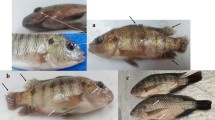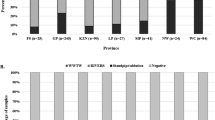Abstract
The genotyping of Blastocystis hominis clinical isolates obtained from 28 gastrointestinal symptomatic patients and 16 asymptomatic individuals were identified by polymerase chain reaction using sequenced-tagged site (STS) primers. Then, pathophysiological variability between different B. hominis genotypes was evaluated in experimentally infected rats. Only four B. hominis subtypes (1, 2, 3, and 4) were detected (18.2%, 9.1%, 54.5%, and 18.2%, respectively) in human isolates. In symptomatic isolates, subtypes 1, 3, and 4 were detected in 8 (28.6%), 16 (57.1%), and 4 (14.3%) patients, respectively. In asymptomatic isolates, subtypes 2, 3, and 4 were identified in 4 (25%), 8 (50%), and 4 (25%), respectively. Subtype 3 was the commonest in humans. Different degrees of pathological changes were found among infected rats by symptomatic subtypes compared with asymptomatic subtypes. The moderate and severe degrees of pathological changes were found only in symptomatic subtypes infected rats while mild degree was found only in asymptomatic subtypes infected rats. Only subtype 1 induced mortality rate with 25% among infected rats. On evaluation of the intestinal cell permeability in the Ussing chamber, a prominent increase in short circuit current (ΔIsc) was found in symptomatic subtype 1 compared to symptomatic subtypes 3 and 4 infected rats. Minimal effects were found in the asymptomatic and control groups. The results proved that subtype 1 was clinically and statistically highly relevant to the pathogenicity of B. hominis while subtype 2 was irrelevant. Also, the results suggest the presence of pathogenic and nonpathogenic strains among subtypes 3 and 4.



Similar content being viewed by others
References
Abe N, Wu Z, Yoshikawa H (2003) Molecular characterization of Blastocystis isolates from birds By PCR with diagnostic primers and restriction fragment length polymorphism analysis of the small subunit ribosomal RNA gene. Parasitol Res 89:393–396
Abou-El Naga I, Negm A (2001) Morphology, histochemistry and infectivity of Blastocystis hominis cysts. J Egypt Soc Parasitol 31(2):627–635
Al-Tawil Y, Gilger M, Gorpalakrishna G, Longston C, Bommer K (1994) Invasive Blastocystis hominis infection in a child. Arch Pediatr Adolesc Med 148:882–885
Appleyard C, Wallace J (1995) Reactivation of hapten induced colitis and its prevention by anti-inflammatory drugs. Am J Physiol 269(32):G119–G125
Arisue N, Hasimoto T, Yoshikawa H (2003) Sequence heterogeneity of the small subunit ribosomal RNA genes among Blastocystis isolates. Parasitology 126:1–9
Ashford R, Atkinson E (1992) Epidemiology of Blastocystis hominis infection in Papua New Guinea: age-prevalence and association with other parasites. Ann Trop Med Parasitol 86:129–136
Bajka H, Gillespie M, Steeb B, Reed C, Howarth S (2003) Applicability of Ussing chamber technique to permeability determination in functionally distinct region of the gastrointestinal tract in the rat. Scand J Gastroenterol 38(7):732–743
Böhm-Gloning B, Knobloch J, Walderich B (1997) Five subgroups of Blastocystis hominis isolates from symptomatic and asymptomatic patients revealed restriction site analysis of PCR-amplified 16S-like rDNA. TM IH Trop Med Int Health 2:771–778
Chen T, Chan C, Chen H, Fung C, Chan W, Liu C (2003) Clinical characteristics and endoscopic findings associated with Blastocystis hominis in healthy adults. Am J Trop Med Hyg 69:213–216
Cirioni O, Giacometti A, Drenaggi D, Ancarani F, Scalise G (1999) Prevalence and clinical relevance of Blastocystis hominis in diverse patient cohorts. Eur J Epidemiol 15:398–3930
Clark C (1997) Extensive genetic diversity in Blastocystis hominis. Mol Biochem Parasitol 87:79–83
Dagci H, Ustum S, Taner M, Ersoz G, Karacasu F, Buda S (2002) Protozoon infections and intestinal permeability. Acta Trop 81:116–121
Dunlop S, Hebden J, Campbell E, Naesdal J, Olbe L, Perkins C, Spiller R (2006) Abnormal intestinal permeability in subgroups of diarrheic-predominant irritable bowel syndromes. Am J Gastroenterol 101:1288–1294
Gallagher P, Venglarick J (1985) Blastocystis hominis enteritis. Pediatr Infect Dis 4:556–557
Garcia L (2001) Diagnostic parasitology. ASM, Washington, DC
Gericke A, Burchard G, Knobloch J, Walderich B (1997) Isoenzyme patterns of Blastocystis hominis patients isolates derived from symptomatic and healthy carriers. TM IH Trop Med Int Health 2(3):245–253
Gugliemetti P, Cellesi C, Figura N, Rossolini A (1989) Family outbreaks of Blastocystis hominis associated gastroenteritis. Lancet ii:1394
Horiki N, Maruyana M, Fujita Y, Yonekura T, Minato S, Keneda Y (1997) Epidemiologic survey of Blastocystis hominis infection in Japan. Am J Trop Med Hyg 56(4):370–374
Horiki N, Kaneda Y, Maruyama M, Fujita Y, Tachibana H (1999) Intestinal blockage by carcinoma and Blastocystis ho-minis infection. Am J Trop Med Hyg 60(3):400–402
Hussain R, Jafri W, Zuberi S, Baqai R, Abrar N, Ahmed A, Zaman V (1997) Significantly increased IgG2 subclass anti-body levels to in patients with irritable bowel syndrome. Am J Trop Med Hyg 56(3):301–306
Iguch A, Ebisu A, Nagata S, Saitou Y, Yoshikawa H, Iwatani S, Kimata I (2007) Infectivity of different genotypes of human Blastocystis hominis isolates in chicken and rats. Parasitol Int 56:107–112
Jones W (1946) The experimental infection in rats with Entameba histolytica. Ann Trop Med Parasitol 40:130–138
Kaya S, Cetin E, Aridogan B, Arikan S, Demirci M (2007) Pathogenicity of Blastocystis hominis, a clinical reevaluation. Turk Parazitol Derg 31(3):184–187
Keneda Y, Horiki N, Cheng X, Fujita Y, Maruyama M, Tachibana H (2001) Ribodeme of Blastocystis hominis isolated in Japan. Am J Trop Med Hyg 65(4):393–396
Lanuza M, Carbajal J, Villar J, Mir J, Borras R (1999) Soluble protein and antigenic heterogeneity in axenic Blastocystis hominis isolates. Parasitol Res 85:93–97
Leder K, Hellard M, Sinclair M, Fairley C, Wolfe R (2005) No correlation between clinical symptoms and Blastocystis hominis in immunocompetent individuals. J Gastroenterol Hepatol 20:1390–1394
Leelayoova S, Taamasri P, Rangsin R, Naaglor T, Thathaisong U, Mungthin M (2002) In vitro cultivation a sensitive method for detecting Blastocystis hominis. Ann Trop Med Parasitol 96:803–807
Moe K, Singh M, Ho L, Tan S, Chen X, Ng G, Yap E (1997) Experimental Blastocystis hominis infection in laboratory mice. Parasitol Res 83:319–325
Noёl C, Peyronnent C, Gerbod D, Edgcomb V, Delgado-Viscogliosi P, Sogin L, Carpon M, Viscogliosis E, Zenner L (2003) Phylogenetic analysis of Blastocystis isolates from different hosts based on the comparison of small-sbunit rRNA gene sequences. Mol Biochem Parasitol 126:119–123
Noёl C, Dufernez F, Gerbod D, Edgcomb V, Delgado-Viscogliosi P, Ho L, Singh M, Wintjens R, Sogin L, Carpon M, Pierce R, Zenner L, Viscogliosis E (2005) Molecular phylogenies of Blastocystis hominis isolates from different hosts: implications of genetic diversity, identification of species, and zoonosis. J Clin Microbiol 43(1):348–355
Parkar U, Traub J, Kumar S, Mungthin M, Vitali S, Leelayoova S, Morris K, Thompson A (2007) Direct characterization of Blastocystis from faeces by PCR and evidence of zoonotic potential. Parasitology 134:359–367
Puthia M, Vaithilingam A, Lu J, Tan K (2005) Degradation of human secretory immunoglobulin A by Blastocystis. Parasitol Res 97:286–289
Puthia M, Sio S, Tan K (2006) Blastocystis ratii induces contact independent apoptosis, F-actin rearrangement, and barrier function disruption in IEC-6 cells. Infect Immun 74(7):4114–4123
Rossingnol J, Kabil S, Said M, Samir H, Younis A (2005) Effect of nitazoxanide in persistent diarrhea and enteritis associated with Blastocystis hominis. Clin Gastroenterol Hepatol 3:987–991
Sadek Y, el-Fakahany A, Lashin A, el-Salam F (1997) Intestinal parasites among food-handlers in Qualyobia Governorate, with reference to the pathogenic parasite Blastocystis hominis. J Egypt Soc Parasitol 27(2):471–478
Shlim M, Suresk K, Ho L, Ng G, Yap E (1995) Is Blastocystis hominis a cause of diarrhea in travelers? A prospective controlled study in Nepal. Clin Infect Dis 21:97–101
Sio S, Puthia M, Lee A, Lu J, Tan K (2006) Protease activity of Blastocystis hominis. Parasitol Res 99:126–130
Stark D, Van Hal S, Marriett D, Ellis J, Harkness J (2007) Irritable bowel syndrome: a review on the role of intestinal protozoa and importance of their detection and diagnosis. Int J Parasitol 37:11–20
Tan K (2004) Blastocystis in humans and animals: new insights using modern methodologies. Vet Parasitol 126:121–144
Tan T, Suresh K (2006) Predominance of amoeboid forms of Blastocystis hominis in isolates from symptomatic patients. Parasitol Res 98:189–193
Tan K, Singh M, Yap E (2002) Recent advances in Blastocystis hominis research: hot spots in terra incognita. Int J Parasitol 21:723–726
Ussing H, Zerhan K (1950) Active transport of sodium as the sources current in the short circuit current isolated frog skin. Acta Physiol Scand 23:110–127
Windser J, Macfarlance G, Hughes-Thapa S, Jones A, Whiteside T (2002) Incidence of Blastocystis hominis in fecal samples submitted for routine microbiological analysis. Br J Biomed Sci 59:154–157
Yakoop J, Jafri W, Jafir N, Khan R, Islam M, AsimBeg M, Zaman V (2004) Irritable bowel syndrome: in search of an etiology: role of Blastocystis hominis. Am J Trop Med Hyg 70(4):383–385
Yan Y, Su S, Lai R, Liao H, Ye J, Li X, Luo X, Chen G (2006) Genetic variability of Blastocystis hominis isolates in China. Parasitol Res 99:597–560
Yao F, Qiao J, Zhao Y, Zhang X, Yang J, Li X (2005) Experimental infection of mice with Blastocystis hominis. Zhongguo Jishengchongxue Yu Jishengchongbing Zazhi 23(6):444–448
Yoshikawa H, Wu Z, Nagano I, Takahashi Y (2003) Molecular comparative studies among Blastocystis isolates obtained from human and animals. J Parasitol 89:585–594
Yoshikawa H, Wu Z, Kimata M, Iseki I, Ali M, Hossain B, Zaman R, Haque R, Takahashi Y (2004a) Polymerase chain reaction-based genotype classification among human Blastocystis hominis population isolated from different countries. Parasitol Res 92:22–29
Yoshikawa H, Yoshida K, Nakajima A, Yamanri K, Iwatani S, Kimata M (2004b) Feco-oral transmission of the cyst form of Blastocystis hominis in rats. Parasitol Res 94:361–366
Zuckerman M, Watts M, Ho H, Meriano F (1994) Blastocystis hominis infection and intestinal injury. Am J Med Sci 30(8):96–101
Author information
Authors and Affiliations
Corresponding author
Rights and permissions
About this article
Cite this article
Hussein, E.M., Hussein, A.M., Eida, M.M. et al. Pathophysiological variability of different genotypes of human Blastocystis hominis Egyptian isolates in experimentally infected rats. Parasitol Res 102, 853–860 (2008). https://doi.org/10.1007/s00436-007-0833-z
Received:
Accepted:
Published:
Issue Date:
DOI: https://doi.org/10.1007/s00436-007-0833-z




